[TJPORT 21]
Day 01: Tianjin port-Beijing (L)

After you disembark your ship, your
English-speaking guide and driver will be there to meet you and help you
with your luggage. We�ll then make the drive to the outskirts of Beijing
in order to visit the Great Wall at Mutianyu. Although it has gotten a
face-lift, it avoids the army of tourists that plague Badaling. Mutianyu
offers some breathtaking views of the valley and wall below, and if you
look to your right you�ll see a large sign engraved in the side of the
mountain encouraging you to �Cherish the teachings of Chairman Mao�.
Mutianyu has also become popular for visiting foreign leaders and
celebrities (former U.S. President Clinton visited Mutianyu on one of
his trips to China).
You can hike down to the parking lot, take a cable
car, or take a toboggan ride (highly recommended, and lots of fun!) down
to meet our driver. Following lunch we�ll go to the Ming Tombs.
The Ming Tombs, about 50 km/31 miles from Beijing, are where 13
emperors of the Ming Dynasty (1368-1644) are buried. This site was
carefully chosen for its feng shui principles by the third Ming emperor
Yongle (who also moved the capital from Nanjing to Beijing and began
construction on the Forbidden City). The tomb we will visit, Dingling,
is the tomb of the Wanli Emperor. It is the only one of the Ming Dynasty
Tombs to have been excavated. It also remains the only imperial tomb to
have been excavated since the founding of the People's Republic of
China. After viewing the tombs, we will head to the �Shenlu�, or the
Spirit Way. The Spirit Way leads into the complex, lined with statues of
guardian animals and officials, with a front gate consisting of
three-arches, painted red, and called the "Great Red Gate". The Spirit
Way, or Sacred Way, starts with a huge stone memorial archway lying at
the front of the area. Constructed in 1540, during the Ming Dynasty,
this archway is one of the biggest stone archways in China today.
You will then be driven to your hotel in Beijing,
ending the day�s activities.
Day 02: Beijing-Tianjin Port (L)
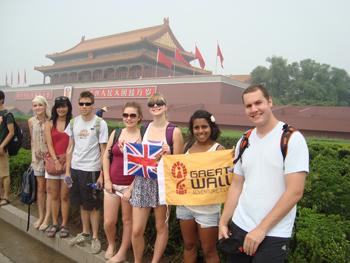
After being picked up in your hotel at about
8:00am, we will head over to the political center of the country,
Tiananmen Square. The largest public square in the world, Tiananmen
Square is seen as China�s political center. Its grounds have seen some
turbulent moments, from the May 4th Movement of 1919 to the political
turmoil of 1989. The south of the square is marked by the Chairman Mao
Memorial Hall, while the center of the square is dominated by the
Monument to the People�s Heroes, an imposing 10-story granite obelisk.
To the east is the National Museum of China, and to the west is the
Great Hall of the People, home to China�s legislative bodies. The north
of the square is dominated by the Gate of Heavenly Peace, known for its
iconic portrait of Mao Zedong, and is the national emblem of China.
After walking across the street, we will enter what
is perhaps the greatest attraction in China, the Forbidden City. After
walking across the square we will enter the Forbidden City (known in
Chinese as Gu Gong), the largest surviving palace complex and the former
home of the emperors of the Ming and Qing Dynasty. The Forbidden City is
one of the greatest attractions in the world. Built by the third Ming
emperor between 1406-1422, the Forbidden City served as the official
residence to the Emperor of China until the last emperor, Puyi, was
forced to evacuate in 1924. The Forbidden City is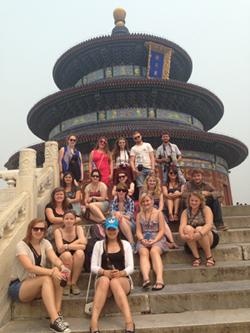 divided into two
parts. The southern section, or the Outer Court was where the emperor
exercised his supreme power over the nation. The northern section, or
the Inner Court, was where he lived with his royal family. Consisting of
980 buildings and with 8,707 bays of rooms, the Forbidden City is the
best example of classical Chinese architecture in the world, and is a
wonder to behold.
divided into two
parts. The southern section, or the Outer Court was where the emperor
exercised his supreme power over the nation. The northern section, or
the Inner Court, was where he lived with his royal family. Consisting of
980 buildings and with 8,707 bays of rooms, the Forbidden City is the
best example of classical Chinese architecture in the world, and is a
wonder to behold.
After lunch we will explore the Temple of Heaven
park. The complex was visited by the Emperors of the Ming and Qing
dynasties for annual ceremonies of prayer to Heaven for good harvest.
The Temple of Heaven park is best known for the Hall of Prayer for Good
Harvests, an iconic building famed for its magnificent triple-gabled
circular roof. You will also have an opportunity to walk the same
imperial walkway that the same emperors walked hundreds of years ago in
their holy rites. You will also see Beijing�s senior citizens using the
park grounds for everything from tai chi and ballroom dancing to
bullwhip practice!
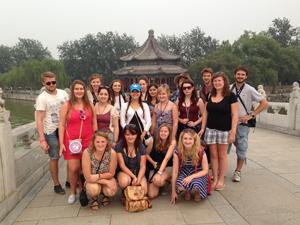
Following a Chinese lunch we�ll next go to the
Summer Palace. Being northwest of the city center, the Summer Palace has
the largest royal park and being well preserved, the Summer Palace is
ranked amongst the most noted and classical gardens of the world. In
1998, UNESCO listed it as one of the World Heritage Sites. Like most of
the gardens of Beijing, it could not elude the rampages of the
Anglo-French allied force of 1860 and was destroyed by fire. In 1888,
Empress Dowager Cixi embezzled navy funds to reconstruct it for her own
benefit, changing its name to Summer Palace (Yiheyuan). She spent most
of her later years there, dealing with state affairs and entertaining.
Highlights not to be missed are climbing Longevity Hill, viewing the
Empress Dowager Cixi�s extravagant Marble Boat, and talking a walk down
Suzhou jie, a canal meant to resemble the beautiful river city of
Suzhou.
You will then be taken your Beijing hotel for the
night.
Day 03: Beijing-Tianjin Port (B, L)
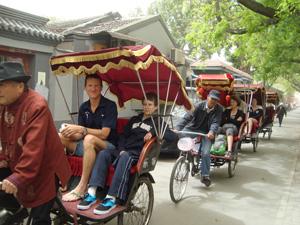 Following breakfast in your hotel we�ll first set
out for the Houhai lake area for your Hutong tour. Hutongs are courtyard
homes grouped together around narrow alleys, and served as the lifeline
and center of everyday life in old Beijing. The Hutongs were a critical
component in the development and evolution of Beijing folklore and
culture. Going on this Hutong tour by rickshaw, you will feel like you
have traveled back in time to a far different China, one where there was
still an emperor sitting in the Forbidden City, and where there was
still enough time to enjoy the simple pleasures of common life.
Following your Hutong tour we�ll visit the old Drum Tower, which was
built in1272 during the reign of Kublai Khan, at which time it stood at
the very heart of the Yuan capital Dadu. In ancient times the upper
story of the building housed 24 drums, of which only one survives. Its
head is made of an entire ox hide and is 1.5 meters in diameter. A sword
score on the side of the drum is a souvenir of the Eight-Power Allied
Forces' invasion of Beijing in 1900.
Following breakfast in your hotel we�ll first set
out for the Houhai lake area for your Hutong tour. Hutongs are courtyard
homes grouped together around narrow alleys, and served as the lifeline
and center of everyday life in old Beijing. The Hutongs were a critical
component in the development and evolution of Beijing folklore and
culture. Going on this Hutong tour by rickshaw, you will feel like you
have traveled back in time to a far different China, one where there was
still an emperor sitting in the Forbidden City, and where there was
still enough time to enjoy the simple pleasures of common life.
Following your Hutong tour we�ll visit the old Drum Tower, which was
built in1272 during the reign of Kublai Khan, at which time it stood at
the very heart of the Yuan capital Dadu. In ancient times the upper
story of the building housed 24 drums, of which only one survives. Its
head is made of an entire ox hide and is 1.5 meters in diameter. A sword
score on the side of the drum is a souvenir of the Eight-Power Allied
Forces' invasion of Beijing in 1900.
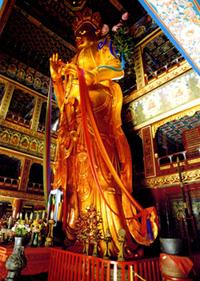
After lunch we�ll then make our way to the Lhama
Temple. Other than the temples in Tibet this is the best Buddhist temple
in China. Work on the Lhama Temple originally began in 1694 during the
Qing dynasty. It served as an official residence for court eunuchs. It
was then converted into the home of the Prince Yong, a son of the Kangxi
Emperor and himself the future Yongzheng Emperor. It was converted into
a lamasery after his ascension to the throne in 1722. Today the Lhama
Temple still functions as a monastery and temple of the Geluk School of
Tibetan Buddhism. Walking through the temple your senses will be
enveloped by the incenses and the chanting of the visiting monks and
other followers. The rear Pavilion of Ten Thousand Happinesses features
a 26m tall statue of the Maitreya Buddha cared from a single piece of
white sandalwood. It is one of three artworks in the Lhama Temple that
were included in the Guiness Book of World Records, and it is not to be
missed on your visit.
We�ll then head to the northern area of Beijing, in
order to go to the Olympic Green. The Olympic Green was the center of
the event that captivated the world for two weeks in August of 2008, and
is where a majority of the Olympic events took place. The highlights
that you will see today include the Bird�s Nest (officially known as the
Beijing National stadium) and the Water Cube (the Beijing National
Aquatics Center). The stadium gets its nickname from its outward design,
which originated from the study of Chinese ceramics, implementing steel
beams in order to hide supports for the retractable roof,
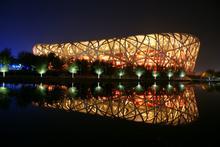 thus giving
the stadium the appearance of a "Bird's nest". The Bird�s Nest hosted
the Opening and Closing Ceremonies, athletic events, and football final
of the 2008 Summer Olympics, from 8 August to 24 August 2008. Since the
Olympics' end, the Bird�s Nest has been used to host events ranging from
opera to a ski park.
thus giving
the stadium the appearance of a "Bird's nest". The Bird�s Nest hosted
the Opening and Closing Ceremonies, athletic events, and football final
of the 2008 Summer Olympics, from 8 August to 24 August 2008. Since the
Olympics' end, the Bird�s Nest has been used to host events ranging from
opera to a ski park.
Afterwards we will drive to Tianjin Home Port
Xingang. Tianjin Port Xingang is about 200 km from Beijing and the drive
will take about 2-3 hours. We should arrive at Tianjin Home Port at
around 4:00pm or your designated time. Your tour guide will escort you
from the beginning to the end. Your tour guide and driver will give you
a hand in carrying your big pieces of luggage to the Tianjin Home Port
Xingang Cruise Terminal Building from the parking lot. Bon Voyage!

